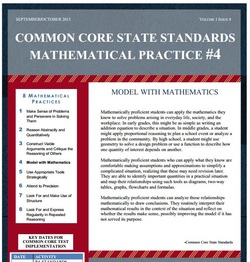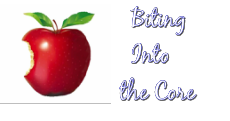SMP #4 Model with Mathematics
The North Carolina Unpacked Standards provide a summary statement about the SMPs for each grade level:
Kindergarten: Mathematically proficient students in Kindergarten model real-life mathematical situations with a number sentence or an equation, and check to make sure that their equation accurately matches the problem context. Kindergarten students rely on concrete manipulatives and pictorial representations while solving tasks, but the expectation is that they will also write an equation to model problem situations. For example, while solving the task “there are 7 bananas on the counter. If you eat 3 bananas, how many are left?” Kindergarten students are expected to write the equation 7-3 = 4. Likewise, Kindergarten students are expected to create an appropriate problem situation from an equation. For example, students are expected to orally tell a story problem for the equation 4+5 = 9.
1st Grade: Mathematically proficient students in Grade 1 model real-life mathematical situations with a number sentence or an equation, and check to make sure that their equation accurately matches the problem context. Grade 1 students rely on concrete manipulatives and pictorial representations while solving tasks, but the expectation is that they will also write an equation to model problem situations. For example, while solving the task “there are 11 bananas on the counter. If you eat 4 bananas, how many are left?” Grade 1 students are expected to write the equation 11-4 = 7. Likewise, Grade 1 students are expected to create an appropriate problem situation from an equation. For example, students are expected to create a story problem for the equation 13-7 = 6.
2nd Grade: Mathematically proficient students in Grade 2 model real-life mathematical situations with a number sentence or an equation, and check to make sure that their equation accurately matches the problem context. Grade 2 students still will rely on concrete manipulatives and pictorial representations while solving problems, but the expectation is that they will also write an equation to model problem situations. Likewise, Grade 2 students are expected to create an appropriate problem situation from an equation. For example, students are expected to create a story problem for the equation 24 + 17 – 13 = ___.
3rd Grade: Mathematically proficient students in Grade 3 experiment with representing problem situations in multiple ways including numbers, words (mathematical language), drawing pictures, using objects, acting out, making a chart, list, or graph, creating equations, etc. Students should have ample opportunities to connect the different representations and explain the connections. Grade 3 students should evaluate their results in the context of the situation and reflect on whether the results make sense.
4th Grade: Mathematically proficient students in Grade 4 represent problem situations in various ways, including writing an equation to describe the problem. Students need opportunities to connect the different representations and explain the connections. They should be able to use all of these representations as needed. Grade 4 students should evaluate their results in the context of the situation and reflect on whether the results make sense.
5th Grade: Mathematically proficient students in Grade 5 experiment with representing problem situations in multiple ways including numbers, words (mathematical language), drawing pictures, using objects, making a chart, list, or graph, creating equations, etc. Students need opportunities to connect the different representations and explain the connections. They should be able to use all of these representations as needed. Fifth graders should evaluate their results in the context of the situation and whether the results make sense. They also evaluate the utility of models to determine which models are most useful and efficient to solve problems.
Wisconsin has a collection of resources for SMP #4 here.
InsideMathematics has an example video of SMP #4 in action from a 5th grade classroom.
Thinkmath.edc.org has a discussion about SMP#4.
Kindergarten: Mathematically proficient students in Kindergarten model real-life mathematical situations with a number sentence or an equation, and check to make sure that their equation accurately matches the problem context. Kindergarten students rely on concrete manipulatives and pictorial representations while solving tasks, but the expectation is that they will also write an equation to model problem situations. For example, while solving the task “there are 7 bananas on the counter. If you eat 3 bananas, how many are left?” Kindergarten students are expected to write the equation 7-3 = 4. Likewise, Kindergarten students are expected to create an appropriate problem situation from an equation. For example, students are expected to orally tell a story problem for the equation 4+5 = 9.
1st Grade: Mathematically proficient students in Grade 1 model real-life mathematical situations with a number sentence or an equation, and check to make sure that their equation accurately matches the problem context. Grade 1 students rely on concrete manipulatives and pictorial representations while solving tasks, but the expectation is that they will also write an equation to model problem situations. For example, while solving the task “there are 11 bananas on the counter. If you eat 4 bananas, how many are left?” Grade 1 students are expected to write the equation 11-4 = 7. Likewise, Grade 1 students are expected to create an appropriate problem situation from an equation. For example, students are expected to create a story problem for the equation 13-7 = 6.
2nd Grade: Mathematically proficient students in Grade 2 model real-life mathematical situations with a number sentence or an equation, and check to make sure that their equation accurately matches the problem context. Grade 2 students still will rely on concrete manipulatives and pictorial representations while solving problems, but the expectation is that they will also write an equation to model problem situations. Likewise, Grade 2 students are expected to create an appropriate problem situation from an equation. For example, students are expected to create a story problem for the equation 24 + 17 – 13 = ___.
3rd Grade: Mathematically proficient students in Grade 3 experiment with representing problem situations in multiple ways including numbers, words (mathematical language), drawing pictures, using objects, acting out, making a chart, list, or graph, creating equations, etc. Students should have ample opportunities to connect the different representations and explain the connections. Grade 3 students should evaluate their results in the context of the situation and reflect on whether the results make sense.
4th Grade: Mathematically proficient students in Grade 4 represent problem situations in various ways, including writing an equation to describe the problem. Students need opportunities to connect the different representations and explain the connections. They should be able to use all of these representations as needed. Grade 4 students should evaluate their results in the context of the situation and reflect on whether the results make sense.
5th Grade: Mathematically proficient students in Grade 5 experiment with representing problem situations in multiple ways including numbers, words (mathematical language), drawing pictures, using objects, making a chart, list, or graph, creating equations, etc. Students need opportunities to connect the different representations and explain the connections. They should be able to use all of these representations as needed. Fifth graders should evaluate their results in the context of the situation and whether the results make sense. They also evaluate the utility of models to determine which models are most useful and efficient to solve problems.
Wisconsin has a collection of resources for SMP #4 here.
InsideMathematics has an example video of SMP #4 in action from a 5th grade classroom.
Thinkmath.edc.org has a discussion about SMP#4.

Noristown Unified School District in Pennsylvania has published some outstanding newsletters which focus on each of the Standards for Mathematical Practice. SMP Newsletter #4 can be found here.


